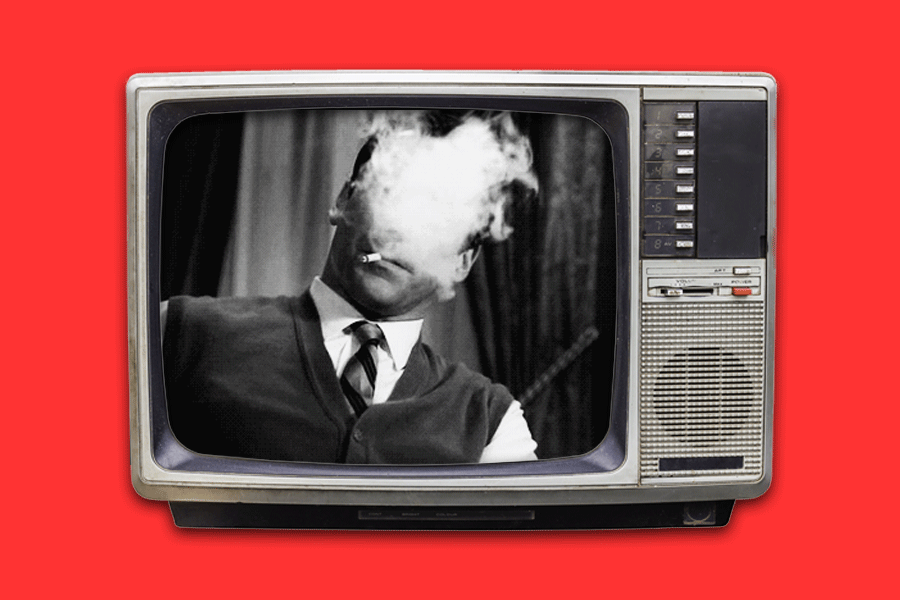I was 18 when I first saw Don Draper light up a cigarette. The next day I went to the gas station and bought a pack of Lucky Strikes so I could be just as cool as him. It was a bit like watching food porn: Monkey see, monkey order Seamless at 2 a.m.
https://www.youtube.com/watch?v=nHPGcheA1jk
Mad Men aside, depictions of cigarette usage on broadcast or traditional TV have been on the decline since the 1960s. Per Variety, “Researchers at Annenberg Public Policy Center found that tobacco use on broadcast television dropped from a high of 4.96 instances per hour of programming in 1961 to 0.29 instances per hour in 2010.”
The same can’t be said for Netflix or other streaming services, however: Based on a recent study by Truth Initiative — cited in a different Variety article — Netflix original series show more depictions of characters smoking than any other TV shows that are popular amongst young people. “Netflix shows contained 319 ‘tobacco incidents’ — more than twice the number in broadcast and cable TV shows, which had 139, per the watchdog organization’s analysis of top series for the 2015–16 season,” writes Todd Spangler.
Since nearly every young person on the planet is binge-watching Netflix shows, based on previous research, that could mean an increase in cigarette smoking, too.
In 2002, a study from the Children’s Hospital in San Diego concluded that young people who watched five or more hours of TV per day were nearly six times more likely to start smoking. Furthermore, the same 2014 study cited in Variety found that a decline in tobacco use on broadcast television coincided with a decline in tobacco use amongst U.S. adults. “An annual change of one tobacco instance per episode hour across two years was associated with an annual change of 38.5 cigarettes, or nearly two packs per U.S. adult,” writes Nikara Johns.
Despite the general decline in onscreen smoking since the 1960s — and although cigarette advertisements have been banned on TV since the passing of the Public Health Cigarette Smoking Act in 1970 — it wasn’t until 2002 that networks began really scrubbing cigarettes from their shows. The cause, by all accounts, was the Children’s Hospital study.
“Over time, awareness of the negative influence such portrayals might be having grew among TV programmers,” writes Christopher Gildemeister in ParentsTV.org. “This awareness may have been accelerated by the publication of a study in the medical journal Pediatrics in 2002, which showed that the prevalence of smoking among U.S. adolescents had increased since 1991, despite bans on television tobacco advertising.”
“It’s a good business decision not to include things that would offend your target audience,” says Walter J. Podrazik, an adjunct lecturer at the Department of Communication at the University of Illinois at Chicago who teaches a course on the future of TV. “If you’re touting yourself as family friendly, it’s just good business not to show smoking or something that’s not family friendly.”
Currently, however, Podrazik says there are no regulations whatsoever on what Netflix can or can’t show on one of their shows. “From what I understand, it’s just self-regulation,” he says. But since there’s technically nothing stopping the same sort of public groundswell that caused broadcast networks give up cigarettes (so to speak), could a similar reaction motivate streaming services like Netflix to curb their depictions of tobacco usage?
Podrazik isn’t convinced. He believes that the issue with streaming services is that, because they’re subscription-based and people are opting into their service, they may be less likely to regulate themselves. “You signed up for it, if you don’t like it, you can leave,” says Podrazik. “So anything like that isn’t going to happen instantly.”
Which is why Podrazik thinks that a tagging program could be one way for Netflix and other VOD services to address the issue of pervasive depictions of smoking on their TV shows. “When you see some programs even on broadcast television, there’s a checklist of what it includes,” says Podrazik. “I could see designating certain shows as ‘smokery’ shows or specifically calling out any show that shows characters smoking in it with some sort of tag. That said, it would just be an editorial nightmare.”
But hey, Stranger Things have happened.

